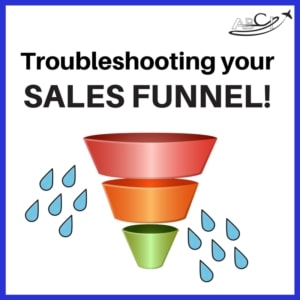 Troubleshooting Your Sales Funnel or “Why am I working so hard & still not closing sales?”
Troubleshooting Your Sales Funnel or “Why am I working so hard & still not closing sales?”
Big ideas from this week’s episode designed around closing sales:
- All of your marketing activities should fit into one of these three phases in a “marketing funnel.”
- Count the number of prospects that are in each phase, and determine where you’re losing the most people.
- Invest the time and money to improve the “leaky section” of your funnel.
This may sound REALLY basic, but we’ve found that many marketers don’t actually do Step #2, and just “wing it” by doing more of the marketing activities that they enjoy, are comfortable with, or feel they can afford.
The problem with this is that you end up wasting money or spinning your wheels.
Listen here:
Watch here:
Transcript – Episode 66- Troubleshooting Your Sales Funnel or “Why am I working so hard and still not closing sales?”
John Williams: You didn’t hit record yet did you?
Paula Williams: Welcome to aviation marketing Hangar Flying episode number 66, Troubleshooting Your Marketing Funnel or why am I working so hard for so few leads.
John Williams: I give up, why?
Paula Williams: [LAUGH] You know.
John Williams: [LAUGH]
Paula Williams: There’s something wrong with your sales funnel.
So we’re gonna talk about that today. So I’m Paula Williams.
John Williams: And I’m John Williams.
Paula Williams: And we are ABCI, and ABCI’s mission is.
John Williams: To help all you folks out there sell more products and services in the aviation industry.
Paula Williams: Absolutely. So if you have questions about closing sales, comments, anything else that you would like us to respond to, use the #AvGeekMarketing.
That will help us find your questions, comments, whatever. And we’ll make sure that we respond to them on social media. We try to reply to every tweet. You can also leave comments on our blog and we welcome those as well. Conversations with people like you that are listening to us really make this a whole lot more fun for us, right?
John Williams: Yes.
Paula Williams: Okay, so big ideas today. One, this is like my New Year’s resolution, measure everything, right? Number two, find the holes in your sales funnel. And three, spend time and money to fix those holes in your funnel, right?
John Williams: Mm-hm.
Paula Williams: Cool, okay so, first of all measure everything.
John Williams: It said fix it, you mean fix them. Cuz you gonna have more than one.
Paula Williams: You gonna have more than one problem with your sales funnel, right? That’s absolutely true. Most people have not done this perfectly and even if you had it perfect it’s not gonna stay perfect, because that’s the way it works.
John Williams: Exactly.
Paula Williams: Right, okay. So most people are familiar with the concept of a marketing funnel. Basically you start with a big end at the top and a little end at the bottom.
John Williams: [LAUGH]
Paula Williams: Our version of this is to kind of divide that funnel into three chunks.
So phase one, which is your advertising and prospecting activities, phase two, which is your building credibility and closing sales process, and phase three, which is your referrals, resales and recaptures. Now, most marketing companies concentrate 90% of their effort on phase one which is advertising and prospecting. And why is that?
John Williams: Cuz they don’t know any better?
Paula Williams: No.
John Williams: [LAUGH]
Paula Williams: They know better. But that’s how they make their money, right?
John Williams: Well, not if you don’t close sales.
Paula Williams: Building beautiful advertising, they don’t care if you close sales. They just wanna win advertising awards for beautiful advertising.
John Williams: You mean aviation marketing companies.
Paula Williams: Yes, aviation-
John Williams: Okay, yeah, yeah, yeah.
Paula Williams: And other types of advertising and marketing companies will want you to spend 99% of your marketing budget on phase one.
John Williams: Sure, I must misunderstood you. You’re right, okay, got it. Okay, yeah.
Paula Williams: Doing advertising and prospecting and this has kind of permeated the culture to the point where everybody is in this frenzy for more leads, more leads, more leads.
We just need more leads. Everything would be fine.
John Williams: And sometimes, you do.
Paula Williams: Yeah, if we had more leads. And that may be the case. But in aviation, it takes longer and a lot of people coming from other fields get really frustrated. I actually just talked with someone this morning who came from a different field other than aviation in our office hours this morning, and was just like, why does this take so long.
[LAUGH] And, you know, the answer is it’s not you. It’s just that there are a lot of decisions that have to be made, a lot of people that need to be consulted. There’s a lot of regulatory things, a lot of procedure things, teams that need to be brought on board before they can change a procedure.There’s a lot of things that have to happen before they can make a purchase. And if you’re used to selling retail, it can drive you crazy, right?
John Williams: Mm-hm.
Paula Williams: So phase two is really, really important. We actually advise that people spend at least 50% of their marketing budget outside of phase one on their phase two and phase three and they’re building credibility and closing sales.
Because we do have a really long sales cycle in the aviation industry. And then phase three, referrals, resales and recaptures, this is where the money is made in the aviation industry, as people who know, like, and trust you already will bring you their friends who are already predisposed and you know they’re in the right demographic and everything else to like your product.
Because they know about it. Your friend’s been telling about them for weeks probably. This worked with John, I think recently, with the Tesla car, right?
John Williams: Well, I didn’t know anybody that had one. I just happened to talk to somebody while I was waiting on you in the store.
Paula Williams: [LAUGH] While I was shopping, and John was waiting.
John Williams: Well, they would go by and I’d roll the window down and said, how do you like the car.
Paula Williams: Mm-hm.
John Williams: He said he wouldn’t have anything else. I said, really?
Paula Williams: That was the referral, right?
John Williams: And so we talked about it a little bit, and I said, okay.
And then she came out, and we had time, so we went to the Tesla dealer.
Paula Williams: And took a test drive.
John Williams: Took a test drive.
Paula Williams: Yep, and since then?
John Williams: Well, I’m just waiting on a contract or two to come in and we’re gonna have one.
Paula Williams: [LAUGH] Exactly, they’re really really cool cars and there’s a lot to talk about, but the reason that I’m bringing this up is because what brought John into the Tesla store was a referral from a happy customer.
John Williams: Right, it didn’t have anything to do with phase one and two.
Paula Williams: Right and you’re not even a customer yet because you haven’t actually bought one of these cars, but you had told two people that I know of.
John Williams: [LAUGH]
Paula Williams: Three people that I know of, at least ten minutes of story about our experience.
John Williams: And not only that, but once we purchase said vehicle from Tesla, I will not ever have another gasoline powered car, unless I want one for a toy just to play with.
Paula Williams: Right.
John Williams: It won’t be anything to use actually trips or anything.
Paula Williams: So now you’ve told all of these people.
John Williams: [LAUGH] Well, whatever.
Paula Williams: So, let’s see if it works.
John Williams: [LAUGH]
Paula Williams: In phase three, for high end products and for innovative products and other kinds of things, is absolutely where the money is made.
Okay, so I’m gonna actually simplify this a little bit further.
John Williams: Just skip.
Paula Williams: Okay, so we’re simplifying our funnel and this is going to be kind of magical math, everything ends in a zero. This isn’t what it’s gonna look like in real life, but to give you an idea, a real simple example of how this can work with the marketing funnel, we have our phase one, phase two and phase three.
The first thing that happens when somebody comes into contact with this fictitious company we’ve got a bunch of different marketing activities going on. We have a website with some search engine optimization and maybe some paid ads and other kinds of things bringing people to the website, to a landing page, where they download a buyer’s guide, right?
John Williams: Uh-huh.
Paula Williams: Okay, we also have a trade show booth, where we are handing out the buyer’s guide. Maybe we have a physical form of that that we’re giving people in return for a business card, okay? So that’s another way that we’re collecting leads for that buyer’s guide.
And then the third way is people come to our website or are referred by somebody or whatever and they just call us. Maybe we have some advertising in some local magazines or in some aviation trade journals or whatever it is.
John Williams: You can cut this part out later but I don’t think I recorded the first part of this.
Paula Williams: Okay.
John Williams: All right, continue.
Paula Williams: So other advertising and things like that we had maybe an advertisement offering, the buyer’s guide call our office and we’ll send you a free copy, right? So three ways to get the same thing. Just to keep it simple.
John Williams: Yes.
Paula Williams: Okay, so we have our advertising and prospecting activities.
And let’s say maybe a thousands people came to our website. A hundred people gave us their business cards at a trade show. And ten people called the office and referred to a particular ad that was in a magazine.
John Williams: Mm-hm.
Paula Williams: Sounds completely unrealistic because everything ends in zero.
John Williams: [LAUGH] That’s good enough to talk about.
Paula Williams: Exactly, okay, so of all of those people, a lot of people come to the website for other reasons, just to read an article or check a phone number or look at a stat or something like that, but of all of those people in the top-end of our funnel, 100 of those people requested our buyers guide, okay.
So that’s a reasonable ratio, right?
John Williams: 1,110 you got 100, that’s 10%, give or take.
Paula Williams: That’s 10%, right, exactly. But of those 10% we only sold one product.
John Williams: Again 10%.
Paula Williams: No, that’s 1%.
John Williams: That’s 1%, sorry.
Paula Williams: Right, that’s okay.
John Williams: Yeah, but that’s still good.
Paula Williams: It can be good. It depends on the product or service and it depends on what we need.
John Williams: If you’re selling gulfstream jets, that’s outstanding.
Paula Williams: [LAUGH] Exactly.
John Williams: [LAUGH]
Paula Williams: If it is selling software for 19.99, it’s not so hot.
John Williams: Right.
Paula Williams: Right, so your ratios are gonna differ and your results are gonna differ and I can guarantee they are not all gonna end in zeros.
John Williams: No, no, but that’s okay.
Paula Williams: Exactly, so basically, we have a big number going into a smaller number going into a smaller number. And then of course, our phase three. How many of those people that we sold to referred other people? And here we have half of one.
So for every two that we sell, one of those people makes a referral, which is pretty good, okay? Cool, so this is a really good way to document your funnel and figure out how many leads do we actually have coming in. Of those, how many are taking the next step in the process?
And of those, how many are taking the next step in the process? And then of those how many are making referrals? Okay, so traditional marketing sales or marketing logic is, okay, now you know what the ratio is you just shovel more things into the top.
John Williams: Mm-hm.
Paula Williams: Okay, that may or may not work.
John Williams: It always works but it may not work as efficiently and effectively as you want.
Paula Williams: As something else and actually it may make it less effective. So this was a really good case with the Groupon. I don’t know if you remember that was really popular couple of years ago.
I guess they’re still a lot of companies that are doing it. But when it first came out people were doing it badly, right?
John Williams: Mm-hm.
Paula Williams: And it’s not Groupon’s fault, just that the campaigns weren’t really well thought out. And there were a lot of flight schools, in particular, that thought, this is fantastic.
We will do super low cost discovery flights for anybody who wants one. And so they would put a super low, ridiculously low price or outlay for a discovery flight and they would barely cover their fuel costs, maybe cover the instructor time, maybe lose money on these discovery flights and to get a lot of leads in the top of their funnel.
But then they didn’t really have a process to capture those leads or qualify those people and to turn them into students.
John Williams: They didn’t even pre-qualify them. A lot of people came out just to go for a ride.
Paula Williams: Exactly, so shoveling more water or pouring more water into the top of your funnel might actually spring more leaks, right?
Because it just can’t take the pressure. [LAUGH] So you don’t want to indiscriminately decide that phase one is your problem and just start advertising for more prospects and not serving them as well as you could. So in a lot of cases those Groupon events were crazy. They had too many people there.
They didn’t have a chance to talk with them. Their customer service was really lousy. They ran out of food. The hamburgers got cold. People got food poisoning. All kinds of stupid things happened because they were just managing the top end of the funnel.
John Williams: And they didn’t think it through?
Paula Williams: And they didn’t think it through, exactly. So what we wanna do is find the holes in your funnel and it might be, especially if you’re a brand new business, you may need more leads. So it maybe that’s where your problem is. But let’s say in our last example that we decided a hundred going down to one was just too many, that 1% of people that requested the buyer’s guide was we sold products to was just too much, too much of a jump.
We could do some asking around of people that left our process and say you know what, you requested our buyer’s guide but then you bought our competitor’s product. Can you tell us why that happened? And it’s just like I understood your competitor’s product better. Or you didn’t talk to me for six months after I requested the buyer’s guide and I completely forgot that you existed.
[LAUGH] You may find out that there is something that you could do that would really convert more of those people to be customers. So maybe you need another step in your funnel. So you have people coming in that you’re doing your advertising, same website traffic, same trade show booth visits, same incoming phone calls, same number of people requesting that buyer’s guide.But now we put in another step where people can request a demo, a personal demo where you’ll actually look at their system and apply some things and do some logic that makes them really understand the product a lot better and then your sales will go up. So in this case we took one sale and turned it into five.
So 50% of the people that went through the demo, if you had a really fantastic killer demo and a good follow up process after that. I’d probably wanna add something else in there, but just for the sake of simplicity, let’s say that that would do the trick. In some cases in your funnel, if you’re losing a lot of people between one step and the next, you just need to add a step rather than spending twice as much money on advertising.
John Williams: And the steps here, just FYI, are completely overly simplified.
Paula Williams: Exactly, in most cases, most marketing funnels have 20 to 30 steps.
John Williams: Yes.
Paula Williams: From beginning to the end. In aviation marketing, it’s a long sale cycle and there’s a lot of information that’s usually needed to make a purchase.
And usually a lot of time that’s required to go through the whole process, right? And probably our referred numbers would go up as well, but even if that’s all we did, even if all we did was change the next step, we’ve still exponentially improved our sales without adding any more money to the top of the funnel.
John Williams: Mm-hm.
Paula Williams: Okay, so you do have to add either time or money. These things aren’t magical. They aren’t gonna do themselves.
John Williams: And customers always cost money.
Paula Williams: Customers always cost money. So when you put together that demo, you probably had to put some money into it.
You may have had to create some materials, create an outline, train your people, do a lot of different things that cost time and money. You can’t just wing it with a lot of these things. [LAUGH] The more scheduled, the more polished, the more together you can be with these steps the better, and of course, you wanna capture that information at every step, so that you can keep continuing to improve.
John Williams: Yes, the funnel itself needs to be polished immaculately.
Paula Williams: Mm-hm, and-
John Williams: You as a person do not, but the process has to be.
Paula Williams: [LAUGH]
John Williams: [LAUGH]
Paula Williams: Exactly, some of the best salespeople are not terribly polished. But they have really good processes and really good outlines and they have systems that work for them.
And that’s another thing is that you can’t just do this once and leave it forever, because customers become more sophisticated. Your competitors are gonna step up their game. A lot of things are gonna happen and your numbers are gonna shift. So now’s the beginning of the year. It’s a really good time to collect your numbers and to put together something like this and say, here’s where our problems are, let’s fix them.
But you’re gonna wanna do that more than once. Maybe do a six-month checkup, certainly a year checkup, and say, here’s all of our systems and here’s all of the numbers going through each of them. Here’s where our customers are slipping between our fingers. [LAUGH] And running off to a competitor, you can’t have that.
You have to make sure you fix that. So big ideas, once again, measure everything, right?
John Williams: Yeah, absolutely.
Paula Williams: Find the holes in your funnel and spend time and money to fix it. So next step, if you want us to help you with this, we have a marketing flight plan where we look at what you have going on.
We help you compile some of this information and put it together and come up with a plan. What is going to be the best place to invest that time and money to help you make more sales? And that marketing flight plan is really the best way that we’ve learned to get to the bottom of that quickly and reasonably easily.
It’s not easy. I won’t lie. [LAUGH]
John Williams: Well, we didn’t start this company to do an analysis of customers, marketing and sales, procedures and processes, but that’s what we end up doing before we can help.
Paula Williams: Right, we don’t wanna spend your money on something that isn’t gonna work.
And that’s why we developed the flight plan is to help us pinpoint where is the best place for you to make those investments to improve your results. Right, okay, so check out the marketing flight plan ABCIone.com/flightplan, and go sell more stuff.
John Williams: Zig Ziglar.
Paula Williams: America needs the business.
John Williams: Yes.
Paula Williams: Right, so and also subscribe to our podcast on iTunes, Stitcher, or Google Play and do leave us a rating. We look forward to those and do take those into account. So have a great afternoon.
John Williams: And we’ll see you next time.
Paula Williams: Right.
John Williams: Ciao.
Podcast: Play in new window | Download
Subscribe: Google Podcasts | Spotify | Amazon Music | RSS

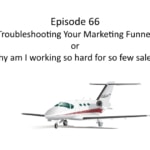

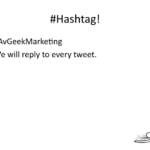
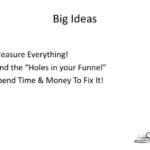
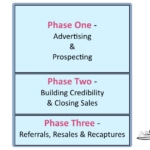
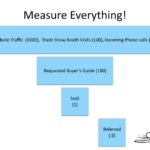
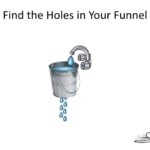
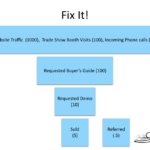
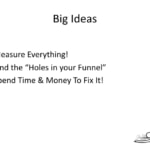
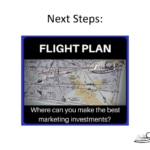
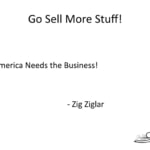
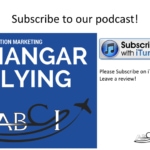





[…] Troubleshooting Your Sales Funnel […]
Hi,
Thanks for the article. Really useful for anyone looking to optimize a sales funnel. I believe a well-optimized funnel is crucial for any business.
Again, thanks for the article!